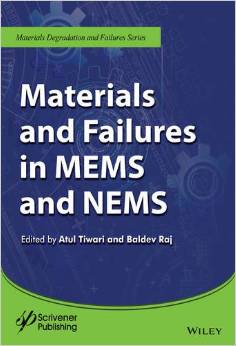 [内容简介]
[内容简介]
The fabrication of MEMS has been predominately achieved by etching the polysilicon material. However, new materials are in large demands that could overcome the hurdles in fabrication or manufacturing process. Although, an enormous amount of work being accomplished in the area, most of the information is treated as confidential or privileged. It is extremely hard to find the meaningful information for the new or related developments. This book is collection of chapters written by experts in MEMS and NEMS technology. Chapters are contributed on the development of new MEMS and NEMS materials as well as on the properties of these devices. Important properties such as residual stresses and buckling behavior in the devices are discussed as separate chapters. Various models have been included in the chapters that studies the mode and mechanism of failure of the MEMS and NEMS.
This book is meant for the graduate students, research scholars and engineers who are involved in the research and developments of advanced MEMS and NEMS for a wide variety of applications. Critical information has been included for the readers that will help them in gaining precise control over dimensional stability, quality, reliability, productivity and maintenance in MEMS and NEMS. No such book is available in the market that addresses the developments and failures in these advanced devices.
[目录]
1 Carbon as a MEMS Material 1
Amritha Rammohan and Ashutosh Sharma
1.1 Introduction 1
1.2 Structure and Properties of Glassy Carbon 3
1.3 Fabrication of C-MEMS Structures 4
1.4 Integration of C-MEMS Structures with Other Materials 15
1.5 Conclusion 18
2 Intelligent Model-Based Fault Diagnosis of MEMS 21
Afshin Izadian
2.1 Introduction 21
2.2 Model-Based Fault Diagnosis 29
2.3 Self-Tuning Estimation 49
3 MEMS Heat Exchangers 63
B. Mathew and L. Weiss
3.1 Introduction 63
3.2 Fundamentals of Thermodynamics, Fluid Mechanics, and Heat Transfer 67
3.3 MEMS Heat Sinks 86
3.4 MEMS Heat Pipes 92
3.6 Need for Microscale Internal Flow Passages 113
4 Application of Porous Silicon in MEMS and Sensors Technology 121
L. Sujatha, Chirasree Roy Chaudhuri and Enakshi Bhattacharya
4.1 Introduction 121
4.2 Porous Silicon in Biosensors 131
4.3 Porous Silicon for Pressure Sensors 155
4.4 Conclusion 165
5 MEMS/NEMS Switches with Silicon to Silicon (Si-to-Si) Contact Interface 173
Chengkuo Lee, Bo Woon Soon and You Qian
5.1 Introduction 173
5.2 Bi-Stable CMOS Front End Silicon Nanofin (SiNF) Switch for Non-volatile Memory Based On Van Der Waals Force 175
5.3 Vertically Actuated U-Shape Nanowire NEMS Switch 184
5.4 A Vacuum Encapsulated Si-to-Si MEMS Switch for Rugged Electronics 187
5.5 Summary 197
6 On the Design, Fabrication, and Characterization of cMUT Devices 201
J. Jayapandian, K. Prabakar, C.S. Sundar and Baldev Raj
6.1 Introduction 201
6.2 cMUT Design and Finite Element Modeling Simulation 203
6.3 cMUT Fabrication and Characterization 205
6.4 Summary and Conclusions 216
7 Inverse Problems in the MEMS/NEMS Applications 219
Yin Zhang
7.1 Introduction 219
7.2 Inverse Problems in the Micro/Nanomechanical Resonators 222
7.3 Inverse Problems in the MEMS Stiction Test 231
8 Ohmic RF-MEMS Control 239
M. Spasos and R. Nilavalan
8.1 Introduction 239
8.2 Charge Drive Control (Resistive Damping) 251
8.3 Hybrid Drive Control 255
8.4 Control Under High-Pressure Gas Damping 258
8.5 Comparison between Different Control Modes 258
9 Dynamics of MEMS Devices 263
Vamsy Godthi, K. Jayaprakash Reddy and Rudra Pratap
9.1 Introduction 263
9.2 Modeling and Simulation 266
9.3 Fabrication Methods 273
9.4 Characterization 276
9.5 Device Failures 280
10 Buckling Behaviors and Interfacial Toughness of a Micron-Scale Composite Structure with a Metal Wire on a Flexible Substrate 285
Qinghua Wang, Huimin Xie and Yanjie Li
10.1 Introduction 285
10.2 Buckling Behaviors of Constantan Wire under Electrical Loading 289
10.3 Interfacial Toughness between Constantan Wire and Polymer Substrate 305
10.4 Buckling Behaviors of Polymer Substrate Restricted by Constantan Wire 310
10.5 Conclusions 321
11 Microcantilever-Based Nano-Electro-Mechanical Sensor Systems: Characterization, Instrumentation, and Applications 325
Sheetal Patil and V. Ramgopal Rao
11.1 Introduction 325
11.2 Operation Principle and Fundamental Models 327
11.3 Microcantilever Sensor Fabrication 330
11.4 Mechanical and Electrical Characterization of Microcantilevers 335
11.5 Readout Principles 339
11.6 Application of Microcantilever Sensors 344
11.7 Energy Harvesting for Sensor Networks 349
11.8 Conclusion 351
12 CMOS MEMS Integration 361
Thejas and Navakanta Bhat
12.1 Introduction 361
12.2 State-of-the-Art inertial Sensor 362
12.3 Capacitance Sensing Techniques 366
12.4 Capacitance Sensing Architectures 367
12.5 Continuous Time Voltage Sensing Circuit 368
12.6 CMOS ASIC Design 371
12.7 Test Results of CMOS–MEMS Integration 377
12.8 Electrical Reliability Issues 378
13 Solving Quality and Reliability Optimization Problems for MEMS with Degradation Data 381
Yash Lundia, Kunal Jain, Mamanduru Vamsee Krishna, Manoj Kumar Tiwari and Baldev Raj
13.1 Introduction 382
13.2 Notations and Assumptions 384
13.3 Reliability Model 385
13.4 Numerical Example 395
13.5 Conclusions 397
References 397

 新书报道
新书报道